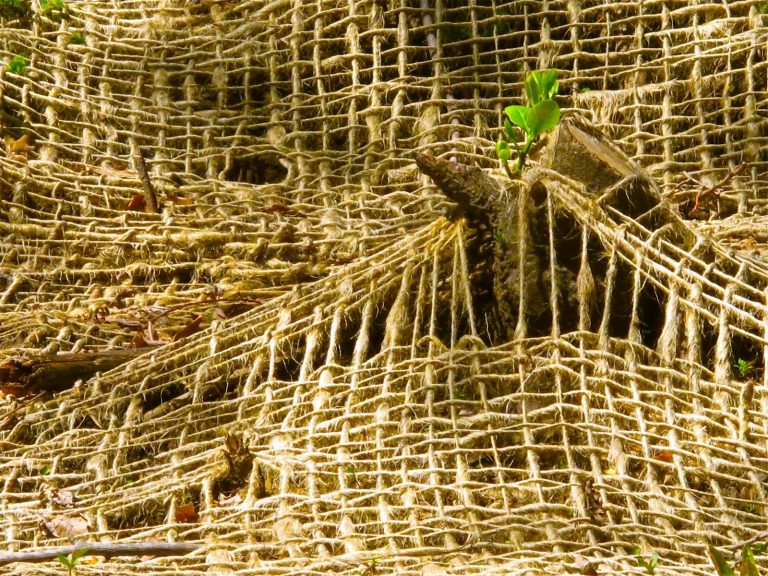- August 23, 2024
- Posted by: wellcoindustries
- Categories: Erosion Control, Jute Mesh
Introduction
In today’s world, where sustainability is more important than ever, jute landscape netting is emerging as a versatile and eco-friendly solution for various landscaping needs. Made from natural jute fibers, this biodegradable material offers numerous benefits for erosion control, soil stabilization, and plant growth. Whether you’re a homeowner looking to enhance your garden or a contractor managing large-scale projects, jute landscape netting provides an effective and environmentally responsible choice.

What is Jute Landscape Netting?
Jute landscape netting is a natural fiber product designed for use in landscaping and erosion control. It is woven from jute, a plant-based material known for its strength and biodegradability. This netting is commonly used to stabilize soil, prevent erosion, and support the establishment of vegetation in various environments. Unlike synthetic materials, jute netting naturally decomposes over time, making it an ideal choice for environmentally conscious projects.
Benefits of Using Jute Landscape Netting
One of the primary benefits of jute landscape netting is its ability to control soil erosion effectively. By holding the soil in place, it prevents erosion caused by wind, rain, and other environmental factors, thereby protecting landscapes and agricultural lands. Additionally, jute netting promotes the growth of vegetation by providing a stable environment for seeds to germinate and roots to establish. Its biodegradable nature means that as plants grow, the netting gradually decomposes, enriching the soil without leaving any harmful residues.
Another significant advantage of jute landscape netting is its environmental impact. As a biodegradable product, it reduces the reliance on synthetic materials, which can persist in the environment for decades. Jute is also a renewable resource, making it a sustainable choice for those looking to minimize their environmental footprint. Furthermore, jute netting is cost-effective and widely available, making it an accessible option for both small and large projects.
Applications of Jute Landscape Netting
Jute landscape netting has a wide range of applications across different sectors. In garden landscaping, it can be used to stabilize slopes, prevent soil erosion, and create a favorable environment for plant growth. It is also extensively used in large-scale erosion control projects, such as along highways, riverbanks, and construction sites, where maintaining soil integrity is crucial.
In agriculture, jute netting supports crop growth by providing a stable foundation for seedlings, especially in areas prone to erosion. It is also useful in construction projects where temporary soil stabilization is required. The versatility of jute landscape netting makes it suitable for various applications, all while contributing to environmental sustainability.
How to Install Jute Landscape Netting
Installing jute landscape netting is a straightforward process that can be done with a few simple tools. Start by preparing the ground where the netting will be placed, ensuring that the soil is level and free from large rocks or debris. Next, roll out the jute netting over the area, starting from the top and working your way down. Secure the netting in place using stakes or pins, making sure it is taut and in close contact with the soil.
For best results, overlap the edges of the netting by at least six inches to prevent gaps. After securing the netting, you can proceed to plant seeds or place sod directly over it. As the plants grow, the netting will help to stabilize the soil and provide a protective layer. Over time, the jute will decompose, leaving behind a healthy and stable landscape.
Why Jute is a Sustainable Choice for Landscaping
Jute is a renewable resource that grows quickly and requires minimal chemical inputs, making it a highly sustainable material. Compared to synthetic alternatives, jute landscape netting has a much lower environmental impact. While synthetic netting can take decades to decompose and may leave harmful residues, jute netting breaks down naturally, contributing to soil health in the process.
Choosing jute landscape netting supports sustainable landscaping practices by reducing waste and promoting the use of natural materials. Its biodegradability and eco-friendly production process make it a superior choice for projects that aim to minimize environmental impact while achieving effective erosion control and soil stabilization.
Conclusion
Jute landscape netting offers a multitude of benefits for both small and large landscaping projects. Its ability to control erosion, promote plant growth, and contribute to environmental sustainability makes it an ideal choice for those seeking to enhance their landscapes responsibly. By choosing jute, you are not only investing in a high-quality material but also supporting a more sustainable future. Consider jute landscape netting for your next project and take a step towards greener, more eco-friendly landscaping solutions.
